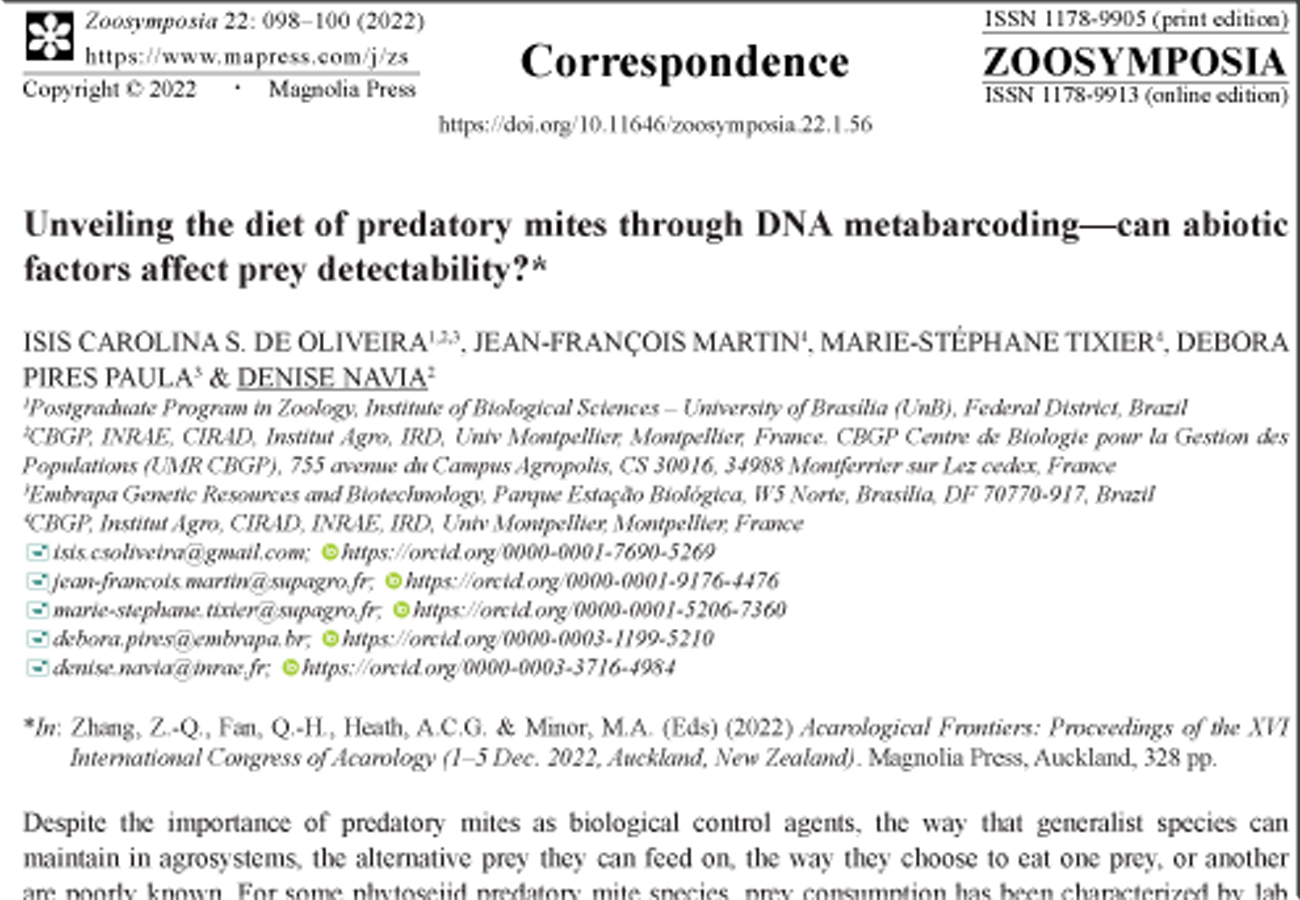Abstract
Despite the importance of predatory mites as biological control agents, the way that generalist species can maintain in agrosystems, the alternative prey they can feed on, the way they choose to eat one prey, or another are poorly known. For some phytoseiid predatory mite species, prey consumption has been characterized by lab tests (Cavalcante et al., 2015, 2017; Juan-Blasco et al., 2012; Oliveira et al., 2007). However, those approaches are sometimes difficult to perform, very time consuming and do not totally reflect interactions occurring in field conditions. New technologies that allow determining the diet of predatory mites in situ are highly desirable to supporting biological control programs. A promising avenue for deciphering the diet of predatory mites is offered by DNA metabarcoding. Although this approach has been used in the study of insects (Hosseini et al., 2008; Kaunisto et al., 2017; Paula et al., 2022), only starts to be applied to microarthropod biological control agents, as predatory mites (Navia et al., 2019). DNA metabarcoding was successfully applied to identify prey species of phytoseiid mites using group-specific primers. However, biotic and abiotic factors can affect the detectability of predatory mite preys through metabarcoding, as previously showed for studies using traditional molecular methods (=PCR Multiplex and Sanger sequencing) (Pérez-Sayas et al., 2015). This information is relevant to understanding the limits of using the methodology, to guide sample collection procedures, and to assure the correct interpretation of the results.
References
Bolyen, E., Rideout, J.R., Dillon, M.R., Bokulich, N.A., Abnet, C.C., Al-Ghalith, G.A., Alexander, H., Alm, E. J., Arumugam, M., Asnicar, F., Bai, Y., Bisanz, J.E., Bittinger, K., Brejnrod, A., Brislawn, C.J., Brown, C.T., Callahan, B.J., Caraballo-Rodríguez, A.M., Chase, J., Cope, E.K., Da Silva, R., Diener, C., Dorrestein, P.C., Douglas, G.M., Durall, D.M., Duvallet, C., Edwardson, C.F., Ernst, M., Estaki, M., Fouquier, J., Gauglitz, J.M., Gibbons, S.M., Gibson, D.L., Gonzalez, A., Gorlick, K., Guo, J., Hillmann, B., Holmes, S., Holste, H., Huttenhower, C., Huttley, G.A., Janssen, S., Jarmusch, A.K., Jiang, L., Kaehler, B.D., Kang, K.B., Keefe, C.R., Keim, P., Kelley, S.T., Knights, D, Koester, I, Kosciolek, T, Kreps, J, Langille, MGI, Lee, J., Ley, R., Liu, Y.X., Loftfield, E, Lozupone C., Maher M., Marotz C., Martin B.D., McDonald, D., McIver L.J., Melnik A.V., Metcalf, J.L., Morgan, S.C., Morton, J.T., Naimey, A.T., Navas-Molina, J.A., Nothias, L.F., Orchanian, S.B., Pearson, T., Peoples, S.L., Petras, D, Preuss, M.L., Pruesse, E., Rasmussen, L.B., Rivers, A., Robeson, M.S. 2nd, Rosenthal, P., Segata, N., Shaffer, M., Shiffer, A., Sinha, R., Song, S.J., Spear, J.R., Swafford, A.D., Thompson, L.R., Torres, P.J., Trinh, P., Tripathi, A., Turnbaugh, PJ, Ul-Hasan, S., van der Hooft, J.J.J., Vargas, F., Vázquez-Baeza, Y., Vogtmann, E., von Hippel, M., Walters, W., Wan, Y., Wang, M., Warren, J., Weber, K.C., Williamson, C.H.D., Willis, A.D., Xu, Z.Z., Zaneveld, J.R., Zhang, Y., Zhu, Q., Knight, R. & Caporaso, J.G. (2019) Reproducible, interactive, scalable and extensible microbiome data science using QIIME 2. Nature Biotechnology, 37(8), 852–857. https://doi.org/10.1038/s41587-019-0209-9
Cavalcante, A.C.C., Mandro, M.E.A., Paes, E.R. & Moraes, G.J. de (2017) Amblyseius tamatavensis Blommers (Acari: Phytoseiidae) a candidate for biological control of Bemisia tabaci (Gennadius) biotype B (Hemiptera: Aleyrodidae) in Brazil. International Journal of Acarology, 43(1), 10–15. https://doi.org/10.1080/01647954.2016.1225816
Cavalcante, A.C.C., Santos, V.L.V. Dos, Rossi, L.C., & Moraes, G.J. de (2015) Potential of five brazilian populations of phytoseiidae (Acari) for the biological control of Bemisia tabaci (Insecta: Hemiptera). Journal of Economic Entomology, 108(1), 29–33. https://doi.org/10.1093/jee/tou003
Hosseini, R., Schmidt, O. & Keller, M.A. (2008) Factors affecting detectability of prey DNA in the gut contents of invertebrate predators: A polymerase chain reaction-based method. Entomologia Experimentalis et Applicata, 126(3), 194–202. https://doi.org/10.1111/j.1570-7458.2007.00657.x
Juan-Blasco, M., Qureshi, J.A., Urbaneja, A. & Stansly, P.A. (2012) Predatory mite, Amblyseius swirskii (Acari: Phytoseiidae), for biological control of Asian Citrus Psyllid, Diaphorina citri (Hemiptera: Psyllidae). Florida Entomologist, 95(3), 543–551. https://doi.org/10.1653/024.095.0302
Kaunisto, K.M., Roslin, T., Sääksjärvi, I.E. & Vesterinen, E.J. (2017) Pellets of proof: First glimpse of the dietary composition of adult odonates as revealed by metabarcoding of feces. Ecology and Evolution, 7(20), 8588–8598. https://doi.org/10.1002/ece3.3404
Navia, D., Tixier, M., Ferragut, F. & Jean-François Martin. (2019) Unveiling the diet of predatory mites through DNA metabarcoding. IOBC Vienna 2019 Working Group “Integrated Control of Plant-Feeding Mites.”
Oliveira, H., Janssen, A., Pallini, A., Venzon, M., Fadini, M. & Duarte, V. (2007) A phytoseiid predator from the tropics as potential biological control agent for the spider mite Tetranychus urticae Koch (Acari: Tetranychidae). Biological Control, 42(2), 105–109. https://doi.org/10.1016/j.biocontrol.2007.04.011
Paula, D.P., Barros, S.K.A., Pitta, R.M., Barreto, M.R., Togawa, R.C. & Andow, D.A. (2022) Metabarcoding versus mapping unassembled shotgun reads for identification of prey consumed by arthropod epigeal predators. GigaScience, 11, 1–13. https://doi.org/10.1093/gigascience/giac020
Pérez-Sayas, C., Pina, T., Gómez-Martínez, M.A., Camañes, G., Ibáñez-Gual, M.V., Jaques, J.A. & Hurtado Ruiz, M.A. (2015) Disentangling mite predator-prey relationships by multiplex PCR. Molecular Ecology Resources, 15(6), 1330–1345. https://doi.org/10.1111/1755-0998.12409
R Core Team. (2021) R: A language and environment for statistical computing. (URL https://www.R-project.org/). R Foundation for Statistical Computing.
Zinger, L., Lionnet, C., Benoiston, A. S., Donald, J., Mercier, C., & Boyer, F. (2021) metabaR: An r package for the evaluation and improvement of DNA metabarcoding data quality. Methods in Ecology and Evolution, 12(4), 586–592. https://doi.org/10.1111/2041-210X.13552


